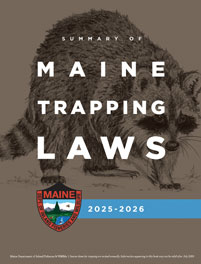Home → Hunting & Trapping → Trapping → Laws & Rules → Identifying Rare Mammals
Identifying Rare Mammals
On this page:
- Large Coyotes
- Large Extirpated Mammals
- New England Cottontail Rabbit
- Track & Track Patterns for Bobcat, Lynx, Coyote, and Domestic Dogs
- Maine Mammal Tracks
Large Coyotes
Although relatively uncommon in Maine, the Department occasionally receives reports of large coyotes (50+ pounds). If you encounter a coyote that is over five feet in total length (tip of the nose to the tip of the tail) and/or weighs over 50 pounds, please contact the Department at (207) 287-5229.
Large Extirpated Mammals
Each year, the Department receives and investigates reports of possible wolf and cougar (mountain lion) sightings. Although wolves were extirpated in Maine by the late 1800s and the last cougar in Maine was killed in 1938, occasionally wolves have been observed near Maine and a cougar was struck and killed by a car in Connecticut in 2011. If you believe you have seen one of these rare mammals, take photos and contact the Department at (207) 287-5229.
New England Cottontail Rabbits
If you are trapping in southern Maine, MDIFW would like to know if you accidentally trap or see New England cottontail rabbits. Cottontail rabbits are smaller than snowshoe hare, have hind feet less than 4 inches in length, and do not turn white in the winter. Their coat remains brown all year round. Please let us know about any rabbits you see. This is Maine’s only native rabbit and MDIFW is actively trying to restore its population. Identifying new areas where the rabbit occurs could greatly benefit restoration efforts.Please let us know about any rabbits you see by contacting MDIFW Small Mammal Biologist Cory Stearns at (207) 592-1782. Sightings should be reported online.
Track & Track Patterns for Bobcat, Lynx, Coyote, and Domestic Dogs
| Species | General Shape | Walking Stride | Print Size (Front Foot) |
Track Pattern |
|---|---|---|---|---|
| Bobcat | General round appearance. Heel points in slightly different direction than toes. No nail marks, but if present, attached to toe marks. | 11" to 23" | Lengt: 1 7/8" to 2 ½" Width:1 7/8" to 2 5/8" |
Direct or double register walking pattern. Trail pattern zigzags right-left-right-left. |
| Lynx | Same as bobcat but tracks show a lot more hair. Smaller pads than a cougar. | 15" to 31" | Length: 3 ¼" to 3 ¾" Width: 3" to 3 3/8" Outline of hair impression: Length: 4 ½" to 5 3/8" Width: 3 3/8" to 5 ½" |
Same as bobcat |
| Coyote | 4 toes, oval shaped track. Front nails often close together. Side nails often do not register. | Eastern: 17 ½" to 26" |
Eastern: Length: 2 7/8" to 3 ½" Width: 1 7/8" - 2 ½" |
Trail pattern usually is in a straight line. Walking pattern is usually direct registering |
| Dog | Similar to wolves and coyotes. Inner toes often splayed outwards. | Varies with breed | Varies with breed | Trail pattern sloppy, wandering, not usually in a straight line. Walking pattern is often double register. |
Maine Mammal Tracks
F - Front track
H - Hind track
T - Tail marks may be present
Tracks Not to Scale
Sizes indicate length of tracks. Depending on the substrate (snow, mud, dust, sand, etc.) and the speed the animal was moving, tracks may show great variability in their appearance.


